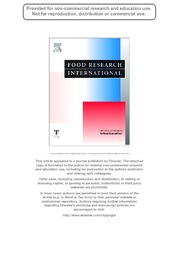Dynamics of the recovery of aroma volatile compounds during the concentration of cashew apple juice (Anacardium occidentale L.).
Dynamics of the recovery of aroma volatile compounds during the concentration of cashew apple juice (Anacardium occidentale L.).
Autoria: SAMPAIO, K. de L.; BIASOTO, A. C. T.; MARQUES, E. J. N.; BATISTA, E. A. C.; SILVA, M. A. A. P. da
Resumo: The objective of this study was to identify and quantify the recovery of aroma volatiles during the concentration of cashew apple juice and propose kinetic models. Fresh juice was concentrated in a thermal-siphon type evaporator, operating in a closed system at 700 mm Hg. The water and volatiles evaporated during concentration were recovered by condensation, generating five condensates: the first was obtained during the concentration of the juice from 10.6 °Brix (fresh juice) to 12 °Brix, the second from 10.6 to 14 °Brix, the third from 10.6 to 19 °Brix, the fourth from 10.6 to 28 °Brix and the fifth from 10.6 to 40 °Brix. The volatiles in the headspaces of the condensates were vacuum stripped (70 mm Hg) to a Porapak Q? trap for 2 h, eluted with 300 μL of acetone, identified by GC?MS and quantified by external standardization. Trained judges rated the intensity of the cashew apple aroma perceived in the condensates using a 9 cm scale. The major classes of volatiles present in the condensates were esters (~90% of the total mass of volatiles), followed by aldehydes (6%) and alcohols (3%). In the first condensate the ester (580.3 μg L−1), aldehyde (39.3 μg L−1) and alcohol (23.5 μg L−1) concentrations were higher than in the remaining condensates, suggesting that a more efficient recovery of the volatiles important to the cashew apple aroma and flavor could be obtained when the beverage was concentrated from 10.6 to approximately 12 °Brix, namely, by condensing the first 23% of the water evaporated off from the juice. The power function was the kinetic model that best fitted the recovery of the esters, aldehydes and alcohols.
Ano de publicação: 2013
Tipo de publicação: Artigo de periódico
Unidade: Embrapa Semiárido
Palavras-chave: Aroma, Caju, Cashew apple, Compostos voláteis, Concentração, Suco de caju
Observações
1 - Por padrão são exibidas publicações dos últimos 20 anos. Para encontrar publicações mais antigas, configure o filtro ano de publicação, colocando o ano a partir do qual você deseja encontrar publicações. O filtro está na coluna da esquerda na busca acima.
2 - Para ler algumas publicações da Embrapa (apenas as que estão em formato ePub), é necessário ter, no celular ou computador, um desses softwares gratuitos. Sistemas Android: Google Play Livros; IOS: iBooks; Windows e Linux: software Calibre.
Acesse outras publicações
Acesse a Base de Dados da Pesquisa Agropecuária (BDPA) para consultar o acervo completo das bibliotecas da Embrapa.

